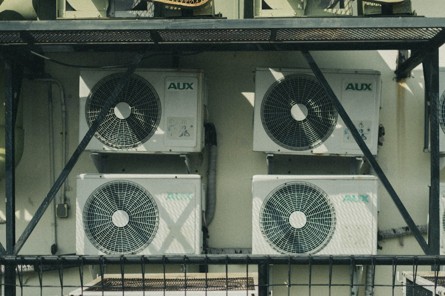Noticing air conditioner mold is one of the most persistent issues AC owners undergo. The issue with mold in the AC is risky because the unit blows air into the rooms, meaning the air will have microscopic mold spores.
Mold spores can cause respiratory infections like allergens. It also leads to more asthma attacks. Luckily, you can clean the mold from your air conditioner. Turn off the unit and clean using diluted bleach or distilled vinegar. Don’t forget to let the unit dry before installing its components back.
Although you can easily clean the air conditioner unit yourself, hire an AC expert to clean the hard-to-reach parts. DIY cleaning these areas could cause damage to your unit, causing expensive repairs and replacements.
Signs of Mold in AC Unit
The AC is an enclosed unit, so you can’t see inside too often. However, when mold grows, your conditioner could start behaving weirdly and you may also notice unpleasant smells. If you suspect mold growth in your HVAC, check for these signs.
1. Visible Signs
You can do a visual inspection after opening up your unit to check the condition it’s in. During the examination, you might notice mold spots in AC vents and other parts. These patches are primarily black or green and can grow with time.
The air conditioner works by removing excess humidity from the indoor air. When the humidity condenses, it becomes water. Mold grows in wet areas, so the air conditioner’s vents provide a conducive environment for its growth.
2. Musty Smell
Most times, you won’t be able to spot mold spots because the AC is enclosed. However, you could notice a change in indoor air quality. If you check and don’t get the source of the smell, there could be mold in the AC.
You can confirm if the source of the musty smell is the air conditioner. When you turn the AC on, the rooms where the unit is located will have a more pronounced smell. It comes from the air vents and can cause discomfort and respiratory problems.
3. Frequent Asthma Attacks and Allergies
Are your family members getting more asthma attacks and other respiratory reactions? The cause of these health symptoms is mold in the AC, because the unit blows the mold spores into the rooms.
When people with respiratory conditions inhale the contaminated air, they experience more issues and triggers; if these symptoms show mostly once you run the AC, it confirms you should clean your unit.
4. Inspection
If you suspect your AC has mold growth, hire a professional HVAC expert to inspect the unit. They open the system to check for black or green patches that symbolize mold growth.
Once the expert notices mold growth in the system, they will use the correct tools and detergents to clean it. The professional mold inspector should also treat the AC to prevent mold growth.
How to Clean Mold in AC
Once you confirm that your air vents or the entire ac have mold growth, you should clean it. Leaving the system uncleaned can lead to more allergies and fatal asthma attacks. Our step-by-step guide will make your AC mold cleaning easier.
You will need:
-
A face mask
-
Gloves
-
Protective glasses
-
Vacuum
-
Cloth
-
Scrub brush
-
Disinfectant
-
Water
Step 1: Turn Off the Air Conditioner
Whether you are checking signs of mold or cleaning the AC, the first step should be powering the unit off. Working on a connected unit can cause fatal electric shocks. It can also damage your system. Turning off the system also prevents the spreading of mold spores in the rooms.
Step 2: Wear Protective Gloves and Eyewear
Mold is dangerous, and you should protect yourself from it. Ensure you have latex gloves not to touch the mold spores with bare hands. You should also protect your eyes with protective glasses. You can get gloves and eyewear from the nearest hardware.
Step 3: Check the Affected Areas
Once you protect yourself fully, start inspecting the areas in the AC with mold growth. Look for dark spots or white fuzzy growths. Other signs of mold infection could be green patches on the ac parts.
If you cannot see the patches with your naked eyes but can smell weird odors, your unit has a mold problem. Get a flashlight for a better look because the system is dark. You can call an HVAC mold professional to clean the unit if the mold has spread too much.
Step 4: Get the Cleaning Solution Ready
Get a bucket and mix the cleaning solution with water. Most homeowners use distilled vinegar or diluted bleach to clean mold. Besides removing and killing the mold, these solutions leave a clean smell in your unit.
Mix a ratio of 1:3 of the cleaning detergent and water in the bucket. If you are using a mold removal solution, it is advisable to let a professional mold cleaner do the cleaning.
Step 5: Unscrew the Air Components and Clean
Use the screwdriver to remove the air components. Remove the top and back of the cabinets together with the vents and filters. It gives you access to the inside of the HVAC. Vacuum the interior of the air conditioner and clean the ducts and filters
Step 6: Scrub and Rinse
Vacuuming the air conditioner might not remove all the mold. Use a soft brush to scrub the unit. Dip the brush in the cleaning solution and use warm water to make the particles easy to remove. Once everything is clean, you can rinse the air conditioner.
Step 7: Let the Unit Dry and Fix the Components
Avoid returning the ACs components when it is still wet. This can cause mold growth in the system, forcing you to do another cleaning sooner than required. Let the unit dry for 24 hours before reinstalling the filters, grilles, and covers. Once everything dries up, you can fix it back to the HVAC.
Final Words
Dealing with air conditioner mold can be dangerous. The mold spores cause respiratory problems to family members and are generally unhygienic, so it’s best to take action once you see signs of mold growth in the AC, and contact an HVAC expert like Hurliman Heating and Air Conditioning for cleaning and tune-up services.





